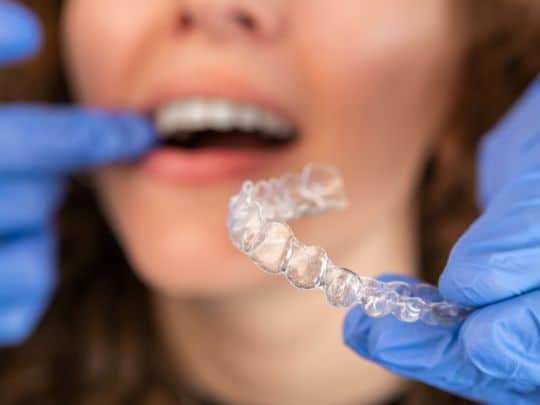Schedule Now
Loose Teeth During Invisalign Treatment: What You Need to Know
Maybe you’ve just completed your Invisalign treatment, or perhaps you have been wearing your aligners for a few months. Either way, you might have noticed that your teeth feel loose with Invisalign. Many patients experience this after undergoing Invisalign treatment, but there are ways to reduce this feeling and ensure your teeth retain their stability. There are many aspects of why you might feel your teeth are loose. In this guide, you’ll find out what causes your teeth to feel loose during your Invisalign treatment and some tips to prevent it.
Understanding Invisalign and How It Works
Invisalign straightens teeth using clear, removable aligners. Custom-made aligners are created from digital impressions of each patient’s mouth. The aligners are nearly invisible, which allows for discreet treatment. You can easily remove them for eating, drinking, brushing, and flossing, which promotes good oral hygiene. Compared to traditional braces, Invisalign typically requires fewer appointments, making it more convenient. However, not everyone is a suitable candidate, and an orthodontist can help you determine if Invisalign or alternative treatments are better for you.
Invisalign and Tooth Mobility: Common Myths and Misconceptions
Several common myths and misconceptions surround Invisalign and its impact on tooth mobility. Let’s explore and debunk some of these misunderstandings.
Myth 1: Invisalign causes teeth to become loose
Invisalign treatment doesn’t make teeth lose. It’s a common belief that the aligners cause loose teeth because of the applied pressure. But it’s not true. Invisalign gradually applies gentle pressure to move the teeth into position. The aligners are customized for a perfect fit, and the pressure is evenly distributed across the teeth. Therefore, it leads to gentle tooth movement.
Myth 2: Teeth become unstable after Invisalign treatment.
After Invisalign treatment, teeth may feel loose or unstable for a short time. The gums and bone tissues need time to adapt to the new position. This is normal, and the teeth will firm up as they adjust. Wearing the recommended retainers after treatment is crucial to maintain the results.
Myth 3: Invisalign causes gaps between teeth.
Invisalign can fix many orthodontic issues, like gaps between teeth. The aligners are customized to fit teeth closely and put gentle pressure to move them into the right positions. Invisalign is meant to close gaps, not make them.
Myth 4: Invisalign treatment is only suitable for minor tooth movements.
Invisalign is a good solution for orthodontic concerns, including moderate to complex cases. Its technology has improved, and it can now move teeth more precisely. Orthodontists can assess if it’s appropriate for complex cases by evaluating the patient’s needs.
Myth 5: Invisalign treatment takes longer than traditional braces.
Invisalign treatment time depends on case complexity and patient adherence. Sometimes, Invisalign is faster than traditional braces. Advanced computer-generated models make treatment planning precise and can reduce the total treatment time.
Myth 6: Invisalign treatment is uncomfortable and painful
Invisalign treatment isn’t usually uncomfortable or painful. You might feel slight discomfort for a few days after you get new aligners, but this is normal. Eventually, you’ll get used to wearing the aligners, and the discomfort will disappear. Invisalign aligners are made of smooth thermoplastic material, so they’re comfortable to wear and won’t irritate your cheeks or gums.
Read Also: Can I Get Invisalign with Missing Teeth?
Does Invisalign Make Your Teeth Looser?
Relationship Between Invisalign and Loose Teeth
The teeth are progressively moved into the proper positions by the aligners’ constant pressures, giving them a brief appearance of minor mobility. However, this feeling is expected as the teeth adjust to new positions. Doctors continuously monitor the process to ensure that the pressures used during therapy are safe and suitable. After completing Invisalign treatment, the teeth may feel slightly loose for a short period as the surrounding tissues adapt and stabilize. Wearing retainers and following post-treatment instructions help the teeth settle into their new positions and regain stability over time.
Is It Normal for Teeth to Feel Loose with Invisalign?
It is normal for teeth to feel slightly loose during Invisalign treatment, this sensation is temporary and does not indicate long-term looseness or instability. This is actually a sign that the clear aligners are working properly. Because Invisalign works by gradually shifting your teeth into their desired position, your teeth may sometimes feel slightly loose. This means that the aligners apply gentle pressure to your teeth, essential for moving them into the correct position.
Managing Loose Teeth with Invisalign
Loose teeth can be a common side effect of Invisalign treatment, but there are many tips and tricks you can try to manage them. Here are some you can put to practice:
- Follow your orthodontist’s instructions on wearing the aligners as prescribed to ensure proper tooth movement and minimize any looseness.
- Avoid excessive biting, chewy foods, crunchy foods, or sticky foods that can put unnecessary pressure on the teeth.
- Use a soft-bristled toothbrush and gentle brushing techniques to avoid putting additional stress on the teeth.
- Gargle with a saltwater solution to help reduce any gum inflammation or discomfort associated with tooth mobility.
- Stay consistent with wearing your aligners for the recommended amount of time each day to ensure continuous progress.
- Attend all scheduled check-up appointments with your orthodontist to monitor the progress and address concerns.
- Drink plenty of water, which helps maintain optimal oral health and may reduce inflammation and other gum disease.
- Avoid smoking, as it can hinder healing and impact tooth stability.
- A balanced diet rich in nutrients supports overall oral health and strengthens teeth.
- Avoid engaging in activities that increase the risk of dental injuries while wearing Invisalign aligners.
- Eat soft foods and use a straw when consuming beverages to minimize contact between the aligners and your teeth, reducing any potential impact on tooth mobility.
- Follow the recommended post-treatment care instructions, including wearing retainers as directed, to maintain the results achieved and promote long-term tooth stability.
Must Read: 7 Invisalign Tips You Should Know for Best Results
When to See Your Orthodontist
Consult your orthodontist as soon as possible if you have a loose tooth due to Invisalign treatment. While some tooth movement is common throughout the realignment process, it is essential to get a professional evaluation to make sure everything is going as planned. Your orthodontist will be able to assess the tooth’s degree of looseness, establish whether it falls within the usual range, and offer the necessary advice.
Invisalign and Loose Teeth: Get Expert Advice from Smile Fort Wayne
If you are undergoing Invisalign treatment and experiencing loose teeth, it is important to address the issue immediately to prevent further complications. At Smile Fort Wayne, we have the expertise and experience to provide guidance to address issues with loose teeth during your Invisalign treatment. Our team of orthodontic professionals will perform a thorough assessment of your teeth to determine the root cause of your issue. As a leading orthodontic treatment provider in Fort Wayne, we are committed to help you achieve a confident and healthy smile.





